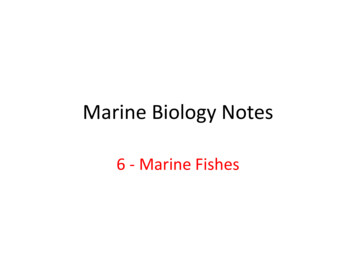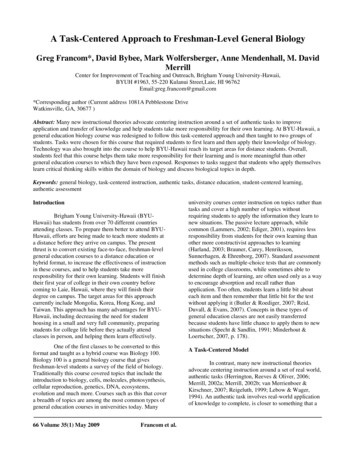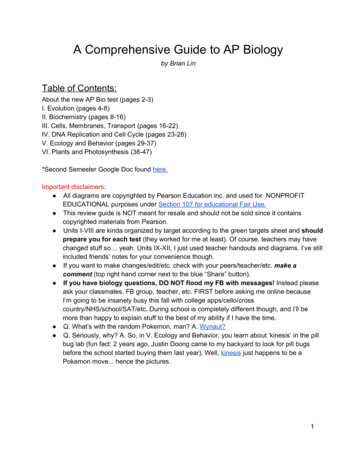
Transcription
Marine Biology Notes6 - Marine Fishes
Classificationof Fishes
Marine Fish Marine fish are vertebrates Some have vertebra made of cartilage, while othershave bony vertebra Of the 24,000 known species of fish, about 15,000species are marine Fish are the oldest of vertebrates (found farther backin the fossil record) Fish are by far the largest group of vertebrates interms of species and abundance About half of all vertebrate species are fish
Types of Marine Fish1. Agnatha (jawless fish) HagfishLampreys2. Chondrichthyes (cartilaginous fish) SharksSkatesRaysratfish3. Osteichthyes (bony fish) Lobe-finned fishesRay-finned fishes
Types of Marine Fish Agnatha– These jawless fish have a muscular, circular mouthwith rows of teeth in rings– Long, cylindrical body– Lack paired fins and scales seen in other fish– Two types of jawless fish exist- hagfish andlampreys
Types of Marine Fish Hagfishes– 20 species– Exclusively marine– They feed on dead and dying fish and marinemammals primarily– Live in burrows in soft sediments– Produce large quantities of mucous from glands inthe skin to protect them while feeding
Types of Marine Fish Lamprey– 30 species– Live in freshwater and salt water– Adults of some species spend a largeportion of their life in the sea, but return tofreshwater to breed; adults normally dieafter breeding.– Other species live in freshwater lakes– They feed on living fish by rasping into thesides of fish with their sucker-like mouthand consuming blood, tissue and bodyfluids.
More Advanced Groups of Fish Fishes in the Chondrichthyes and Osteichthyesare considered to be more advanced. General Characteristics (advancements) seenin these groups:– Highly efficient gills– Scales cover the body– Paired fins– A wide variety of jaw and feeding types– Lateral line and other sensory organs– Streamlined body
Types of Marine Fish Chondrichthyes General Characteristics of Group:– About 1000 species– Sharks, rays, skates and ratfishes are members of thisgroup– Skeleton of cartilage (as the name implies)– Movable jaws with well-developed teeth– Placoid scales and paired fins– 5-7 gill slits open directly into the water in most species– Spiracles in many species (openings on head used to bringwater directly in for respiration without opening themouth)– Males in most species have projections of the anal fincalled claspers that are used in copulation
Types of Marine Fish More specific details about Sharks– Primarily marine, but do travel up the mouths ofrivers into freshwater in some species– The population numbers in many species of sharksare declining due to harvesting sharks for meat, oil,skin and fins– In addition to the lateral line, sharks have a sensoryorgan called the Organ of Lorenzini; this organ is used to detect electrical currents whensharks are close to an object (the movement of muscles –even those used in respiration – emit a small electricalcharge) – this allows sharks to detect living prey even it ishidden from their view if they can get within a few feet ofthe organism
Types of Marine FishMore specific details about Sharks– Most species possess 2 dorsal fins– Reproduction in sharks is varied – some have livebirth (known as vivipary); some lay egg cases(ovipary); while others have an internalized eggthat hatches while still in the female before theyoung are expelled from the female’s reproductivesystem (ovovivipary)– Many are carnivorous, some planktonic– About 350 species currently exist
Types of Marine Fish More specific details about Rays– Rays always have live birth– Pectoral fins are expanded into “wings” and entire body isdorsoventrally flattened– Gill slits (5 pairs) mouth are on the underside of the body– Spiracles are located on the top of the body– Rays spend much of their time on the bottom (demersal) partiallycovered in sand– Large flattened teeth for feeding on molluscs and arthropods– Most have long whip-like tails; in sting rays, there is a spine at the baseof the tail with an associated poison gland– Venom from this gland is delivered to other organisms if they makecontact with this spine by stepping on a ray or making contact with theray in some fashion– Electric rays have organs that produce electricity on either side ofhead
Types of Marine Fish More specific details about Skates– Like rays, skates are dorsoventrally flattened withpectoral fins modified into wings– Unlike rays, skates have a fleshy tail and no spineon the tail– Also unlike rays, skates always lay egg cases– After fertilization, the female lays egg cases withan embryo inside– The embryo develops within the protection of theegg case for weeks to months– They are also demersal (living on the bottom) andfeed on molluscs and arthropods primarily
Types of Marine Fish More specific details about Ratfishes– Only about 30 species– Mostly are deep water inhabitant– One pair of gill slits is covered by a flap of skin(very unusual in the chondrichthyes)– They feed on the bottom on crustaceans andmolluscs primarily– Heterocercal (lobes of different sizes) tail like insharks– Unlike others in this group, they also have fin rays(tiny support rods) in the fins
Shark Videos1. Jonathan Bird's Blue World: Bull Sharks (14:13)2. Naked Science: Shark Attacks (50:12)3. 25 Species of Weird Sharks You Never Heard Of (8:13)
Types of Marine Fish Osteichthyes, The Bony Fish– As the name implies, these fish have a skeletoncomposed of bone– More species that all other vertebrates combinedover 23, 000 species worldwide– Gills used for respiration– Hinged jaws allow for a variety of different ways offeeding– Homocercal tail (two lobes of equal size) providesforward thrust
Types of Marine FishOsteichthyes, The Bony Fish– Flat bony scales (ctenoid or cycloid) protect body– Bony operculum covers the gills (provides betterprotection against injury compared to gill slits foreach gill)– Lateral line used in sensory capacity andcommunication– Swim bladder used for buoyancy control (somebottom dwelling fish lack swim bladder)– Variable body plans are adapted for specificenvironments
Types of Marine Fish Osteichthyes, The Bony Fish– Coloration patterns:– Countershading is seen in virtually all fish species– In countershading, the ventral (belly) area of thefish is lighter than the dorsal area of the fish– This allows the fish to “blend in” with theenvironment– If a fish is seen from above, the darker colorationof the dorsal area blends in with the darker colorof the ocean bottom– If the fish is seen from below, the lightercoloration of the ventral surface blends in with thelighter coloration of the ocean surface
Types of Marine Fish Osteichthyes, The Bony Fish– Coloration patterns:– Slower swimming fish often have bars or stripesthat help break up the silhouette of a fish (a formof disruptive coloration)– This helps with predator avoidance– Some also have coloration that helps them blendin with environment (known as cryptic coloration)
Types of Marine Fish Osteichthyes, The Bony Fish– Coloration Patterns:– It is also not usually to see a fish with circularpatterns on or near the caudal fin– This confuses predators who are not sure whichend of the fish is the head– If the fish at right is attacked on caudal end wherethe black dot looks like an eye, he can probablyget away with minor damage– However, if he is attacked on his head region, hemay sustain serious, life threatening damage– Some fishes may also use color to advertise theirbad taste or poisonous nature – this is known aswarning coloration
Types of Marine Fish Osteichthyes, The Bony Fish– Body shapes vary greatly among fish dependenton the environment that fish calls home– For example, flounders and soles live on thebottom and cover themselves slightly with sand tocamouflage themselves from potential predatorsas well as prey– The flat shape of the flounders and soles is welladapted to this lifestyle
Types of Marine Fish Osteichthyes, The Bony Fish– Body shapes, continued– Tuna, billfish, and other fast moving predators arelong, streamlined and most of their fins serve asrudders basically (very little flexibility except incaudal fin)– This body shape allows these predators to cutthrough the water quickly– Notice, too, that the area of the body called thecaudal peduncle (area just before the tail) is verythin – this allows all the muscles to concentrate inthis area allowing for greater thrust of the caudal(tail) fin (this means FAST swimming capabilities)
Types of Marine Fish Osteichthyes, The Bony Fish– Body shapes, continued– By contrast, the angelfish represents the oppositeenvironment– Angelfish and many other fish do not inhabit the openwaters of the ocean like tunas and billfish do– Angelfish and the like inhabit coral reefs, oyster reefs andother similar environments– In these fish, the body is not as streamlined and the finsare feather-like for lots of flexibility– This flexibility allows for greater control around thefeatures that would be seen in a coral reef typeenvironment (crevices, etc)
Types of Marine Fish Osteichthyes, The Bony Fish– Body shapes, continued– Other fish have a shape that allows forcamouflage in their environment– For example, fish like the toadfish and thestonefish actually look like rocks or “scenery” andthus can go undetected by predators or prey
Swimming Patterns Fish exhibit an “s-shaped” swimming pattern Bands of muscle along the body calledmyomeres drive this swimming motion Depending on the type of fish, different finsmay be used primarily for the forwardmovement
Swimming Patterns In sharks, a swim bladder is absent (althoughthere is a large lipid-rich liver to help inbuoyancy) – therefore, sharks tend to sinkwhen not in motion and there is no lift fromthe swim bladder while swimming either While swimming, sharks are aided by the “lift”provided by the position and stiffness of thepectoral fins
Swimming Patterns In bony fish, pectoral fins are not needed for lift andthus are normally not stiff in construction (exception:fast swimming species like tuna, billfish, etc) In contrast, the pectoral fins in many bony fins areflexible and used for maneuverability In some slower-swimming species, forwardmovement is mainly provided primarily by thepectoral fins
Swimming Patterns In other species, all the fins may be flexibleand highly modified for camouflage (example:sea horses and sea dragons) This means that the fins will not allow forsignificant forward movement
Fish Gills The construction of the gill is the same in allfish – gill arch supports the entire structure,gill rakers are on the forward surface of the gillarch and gill filaments trail behind the gill arch Like in the human lung, exchange of oxygenand carbon dioxide takes place on thesesurfaces
Acquiring and Processing Food Mouth structure also reveals the dietary preferencesof fish As an example, the “beak” (fused teeth) seen inparrotfish allows for these fish to scrape algae andother organisms off of hard surfaces The butterfly fish uses its long tube-like mouth to feedon corals While the barracuda uses rows of sharp teeth and awide mouth to capture its prey – other fish
Acquiring and Processing Food The position of the mouth is also important A strongly forward facing mouth is importantin fish who chase down their prey (as seen inbarracuda) A downward facing mouth would be seen infish feeding at/near the bottom
Acquiring and Processing Food Digestion of food in fish is completed with theaid of a stomach, intestine (with anus), liver,pyloric caeca and pancreas The stomach is structured very similarly to thehuman stomach – stretch receptors in the wallof the stomach indicate when a meal ispresent and needs to be mechanicallydigested by the churning motion of thestomach wall
Acquiring and Processing Food The intestine, pyloric caeca, pancreas and liver allsecrete digestive enzymes to aid in the digestionprocess The intestines of carnivorous fish tend to be shortand straight while the intestines of herbivorous fishare longer and more coiled (plant and algae materialis more difficult to process, so it needs to stay in theintestines longer)
The Circulatory System Fish have a two chambered heart that serves topump blood throughout the body (in contrast to the4 chambered heart seen in mammals) A system of arteries, veins and capillaries takes bloodto the body tissues and returns it for re-oxygenationby the gill filaments Oxygen and carbon dioxide will diffuse across thethin membranes of the capillaries either in the gillsor at the tissues of the body
Fluid Balance in Fish Remember from earlier studies that the forces ofosmosis and diffusion are always at work in anorganism Solutes and gases will travel from areas where theyare more concentrated to areas where they are lessconcentrated Since marine fish are living in an environment wherethe water is very solute-rich, these fish have atendency to gain solutes and lose water Therefore, fish need to have mechanisms to combatthis issue – this is called osmoregulation
Fluid Balance in Fish Osmoregulation is the term given to theprocess of managing internal water/solutebalance Fish have evolved a variety of ways toosmoregulate including:– Many fish swallow seawater but them expel thesolutes in the digestive process (this allows themto keep the water and lose the solutes)– Most marine fish pass very little urine– This urine (processed by the kidneys) is highlyconcentrated with solutes with very little watercontent
Fluid Balance in Fish Osmoregulation continued:– In cartilaginous fish, the blood is kept at about thesame concentration as seawater– This is accomplished by keeping urea in thebloodstream (this toxin is filtered out of the bloodby other organisms)– This means that no solutes are gained (or waterlost) because the concentration internally andexternally match
The Fish Nervous System The fish have a brain, spinal cord and numerous nerves likeother vertebrates Fish also possess olfactory sacs (with nostrils) for smelling Taste buds are located in the mouth, lips, barbels and skin The eyes are structured slightly differently In humans, the lens changes shape for focusing on items In fish, the position of the lens changes like in a camera
The Fish Nervous System In some sharks, the eye is covered by anictitating membrane that covers the eye –this clear membrane helps these predatorsprotect the eye, especially during feeding Incidentally, this membrane is also seen insome reptiles
The Fish Nervous System All fish rely heavily on the lateral line system The lateral line is a series of pores and canals linedwith cells called neuromasts that are specialized todetect vibrations These vibrations can indicate a predator or prey orthe position of other fish in a school
The Fish Nervous System Cartilaginous fish also possess the organ (orampulla) of Lorenzini This organ detects electrical charges All muscular system of organisms relies onsmall electrical charges Therefore, this organ can help cartilaginousfish detect prey, even if they are not visible(buried in sand, etc)
The Fish Nervous System The inner ears are set in fluid-filled canals withsensory cells similar to the lateral line system.
Behaviors in Fish Schooling– Schooling is used by a wide variety of fish– Schooling makes it possible for a group of smallerfish to appear much larger (as thus avoiddetection by predators– It also makes it harder for a predator to captureany one fish– Because of this, many fish school as juveniles– About 4000 species school as adults
Behaviors in Fish Territoriality– Some fish are territorial by nature all the time,others are only territorial during reproduction– Fish maintain their territories normally by“posturing” to show their aggression– Posturing can include raised fins, open mouth,darting, etc.– Fights between individuals are actually rare
Behaviors in Fish Some species migrate between freshwater andsaltwater at different times in their life Anadromous species like salmon, lampreys andsturgeon live in saltwater normally but go tofreshwater for reproductive purposes Catadromous species like the American Eel live infreshwater but travel to saltwater for reproduction
Reproduction in Fish Sex hormones control the development of sperm andeggs in fish The release of sex hormones can be cued by watertemperature, day length, specific tide cycles, etc. Broadcast spawning (releases eggs and spermdirectly into water for fertilization) is most common Some fish do have internal fertilization (sperm isinserted directly into the female by the male) Complex mating behaviors are seen in some species
Reproduction in Fish Some fish are hermaphroditic (possess maleand female reproductive organs) Some possess these structures at the sametime (simultaneous hermaphrodites)- this ismore rare Other species possess these structures atdifferent times during the life (sequentialhermaphrodites)
Reproduction in Fish Types of Sequential Hermaphrodites– In protandry, fish are first males and develop intofemales later in life– In protogyny, fish are first females and developinto males later in life– The cues for these changes are often the result ofchanges in social structure or environment– As an example, in some species, a large malekeeps a “harem” of females and he fertilizes theeggs of all– When this male dies, the largest female developsinto a functional male
Reproduction in Fish Depending on the species, fish can either be:– Viviparous – young are born live– Oviparous- egg layers– Ovoviviparous – eggs are kept inside and “hatch” before beingreleased from female reproductive tract– In most bony fish, eggs are laid by the thousands or millionsand are not protected by the parents– In other bony fish, smaller numbers of eggs are laid and theparent(s) protect the eggs– RARE: A few species are parthenogenic- in this reproductiveplan, young develop directly from the unfertilized eggs of thefemale (no DNA from males) – the young are “clones” of thefemale
Reproduction in Fish In most fish, intricate behaviors are cues forthe release of eggs and sperm (this helpsensure fertilization) In some species, color changes or bodystructure changes may indicate readiness forreproduction
Marine Biology Notes 6 - Marine Fishes . Classification of Fishes . Marine Fish Marine fish are vertebrates Some have vertebra made of cartilage, while others have bony vertebra Of the 24,0










